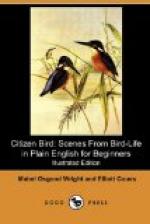“They have fingers, and some birds’ wings have claws; only you cannot see them, because they are all wrapped up in the skin and covered over with the feathers. Some day—not to-day, because you have had a long lesson already—I will show you a bird’s wing with only its bones. Then you will see that it has finger-bones at the end, then hand-bones next, then bones that run from the wrist to the elbow, and then one bone that runs from the elbow to the shoulder—almost the same bones that people have in their fingers, hands, wrists, and arms. So you see wings are the same to a bird that fore legs are to a mouse or arms are to us.
“I could go through all the inside parts of birds, and show you something like the same parts in people,—stomach and bowels, to take care of the food they eat and turn it into blood to nourish them; lungs to breathe with, and keep the blood pure; heart to beat and thus pump the warm blood into all parts of the body; brain and nerves, which are what birds think and feel with, just as we do with ours; and all their bones, which together make what we call the skeleton, or framework of the body, to keep the flesh in shape and support the other organs.”
“Dear me!” sighed Dodo; “there must be ever so many more things inside of birds that we can’t see, than there are outside.”
“Of course there are!” said the Doctor. “It won’t be very hard for you to remember the outside parts, and learn the names of them all. I have told you most of them that you need to remember, to understand the stories I am going to tell you about birds. See here! What do you think of this?”
[Illustration: Outside parts of a bird.]
So saying, the Doctor unrolled a large sheet of drawing-paper that hung on the wall. “Here is a picture of the White-throated Sparrow, drawn so big you can see it almost across the room, with all the outside parts of which you must learn the names. You see the names are all on the picture, too; I am going to make it smaller, and put it in the book I will write for you, so you can look at it whenever you wish.
“It is almost dinner-time now, and you must be very hungry. But now I must tell you one thing more. You know there are so many, many different kinds of birds and other animals that nobody could remember them unless they were classified. To classify is to put things that are most alike closest together, then next nearest them things that are next most alike, and to keep furthest apart those things that are least alike. Now it is true that all beasts, birds, snakes, lizards, frogs, and fishes have some things alike, though each has some other things different from all the rest. If they were not all alike in some things, we could not call them all animals. One of the things in which all the animals I have named are alike is, that they all have skeletons. One of the things in which all their skeletons are alike is, that they have backbones. Backbones are the chains of bones that run along the back from the head to the tail. Backbones are called by the Wise Men vertebrae; animals that have backbones are named Vertebrates; and animals that lack backbones are named Invertebrates.”




